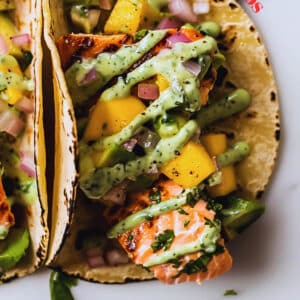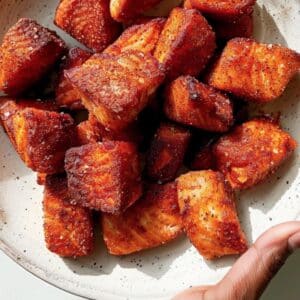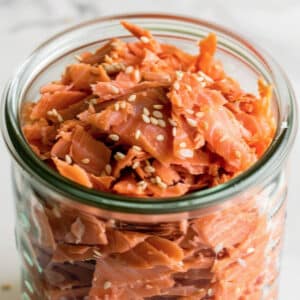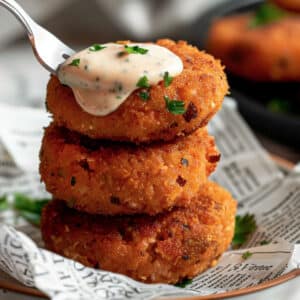Tired of the same old salmon recipes routine? It's time to level up your fish game! Learn how to cook salmon perfectly, explore exciting flavor pairings, and discover new ways to enjoy this delicious and healthy fish. Discover different types of salmon, foolproof cooking methods, and global flavors destined to become your new favorites.
Jump to:
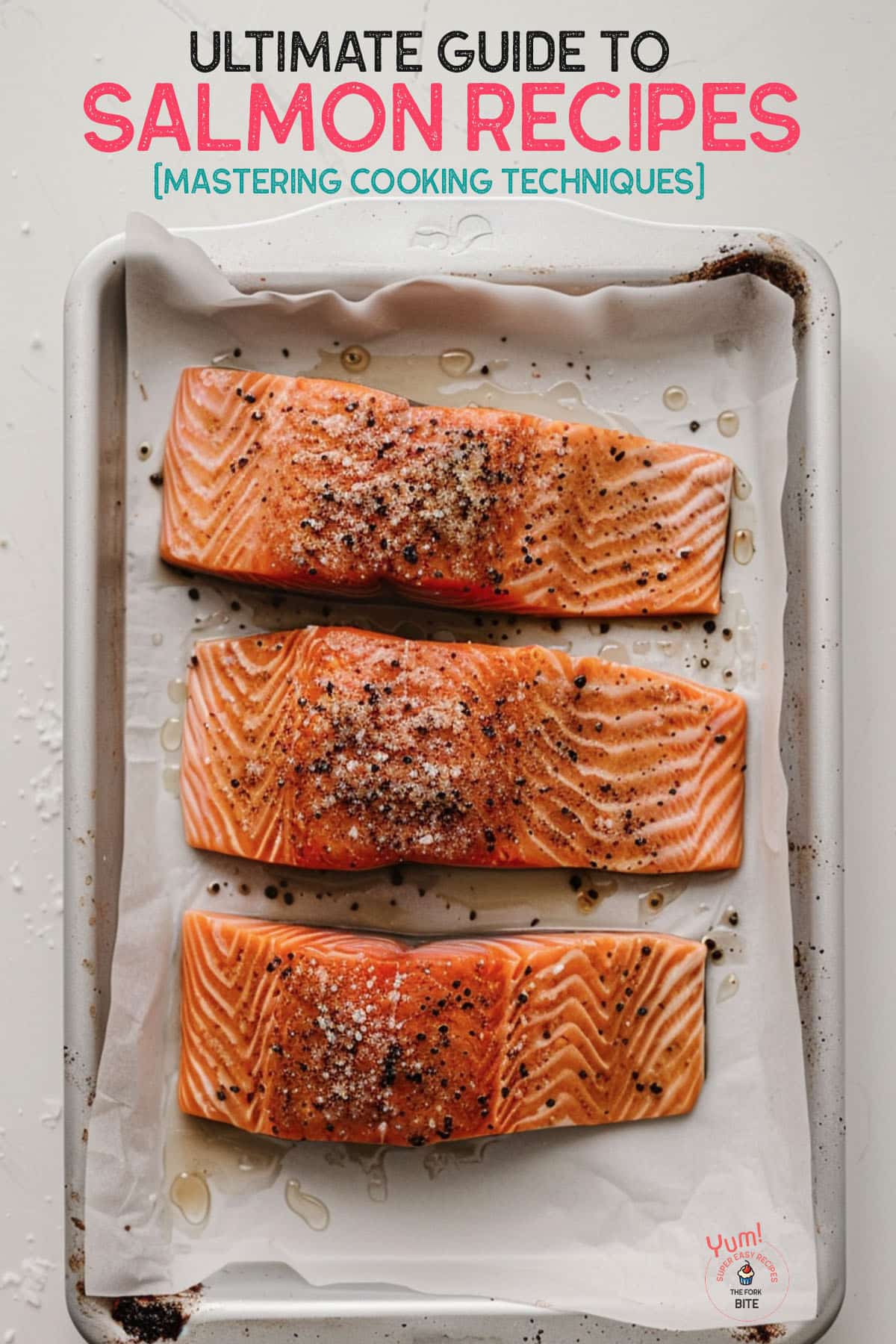
Types of Salmon
Chinook (King)
- Flavor Profile: The richest, most buttery of all salmon varieties. Deeply flavorful with a high oil content. Read more about King Salmon here.
- Texture: Luxuriously soft and melts in your mouth due to its high-fat content.
- Ideal Cooking Methods: Grilling (the fat content withstands high heat), baking, smoking (subtly enhances the rich flavor), pan-searing (with care, as it can be easy to overcook).
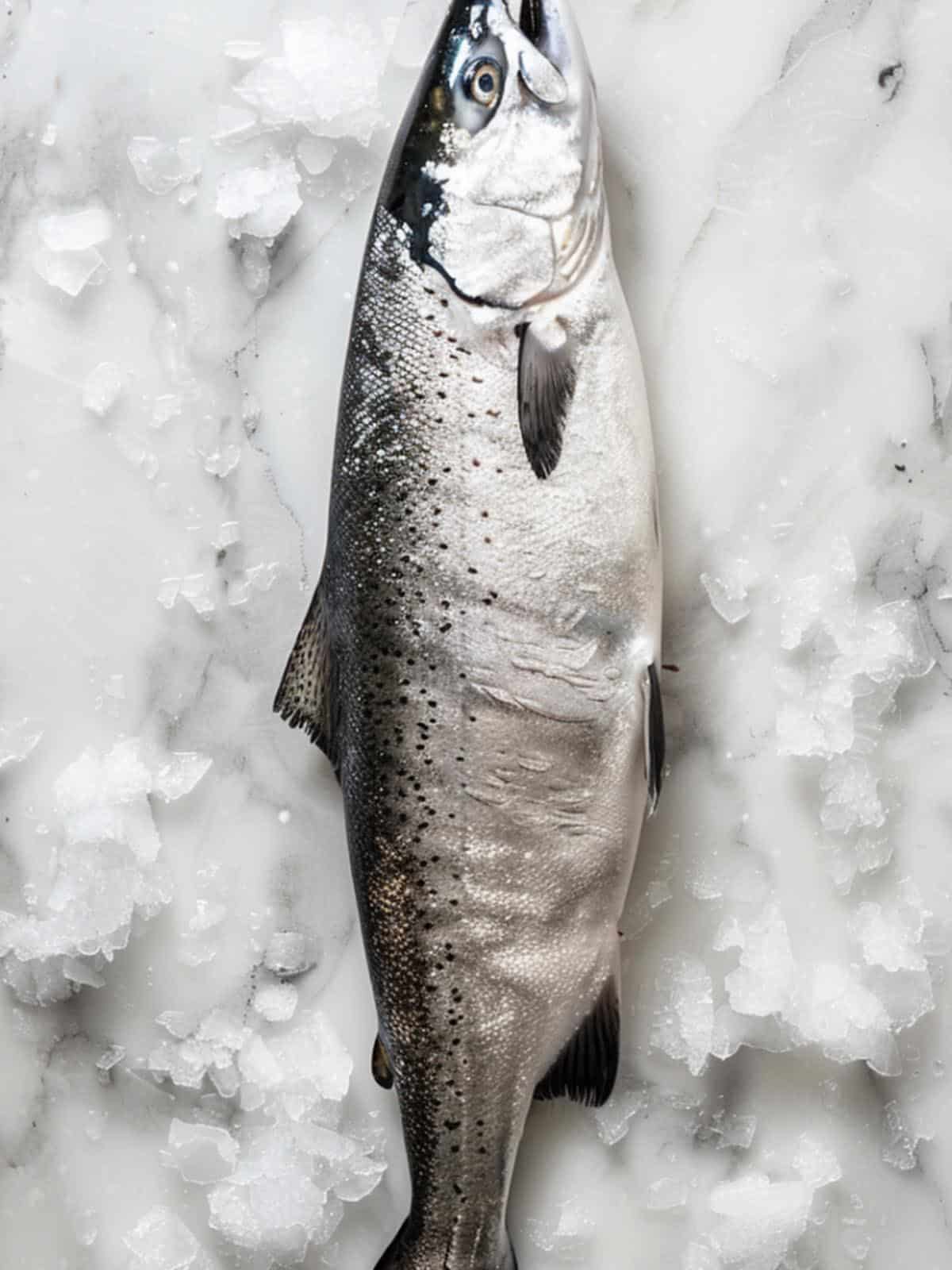
Sockeye
- Flavor Profile: A bold and assertive flavor profile for salmon lovers, less "fishy" than some other varieties. You can find more information here.
- Texture: Firm yet flaky, holds its shape well during cooking.
- Ideal Cooking Methods: Grilling, pan-searing, salads (holds up well to bold dressings), and poaching with flavorful liquids.
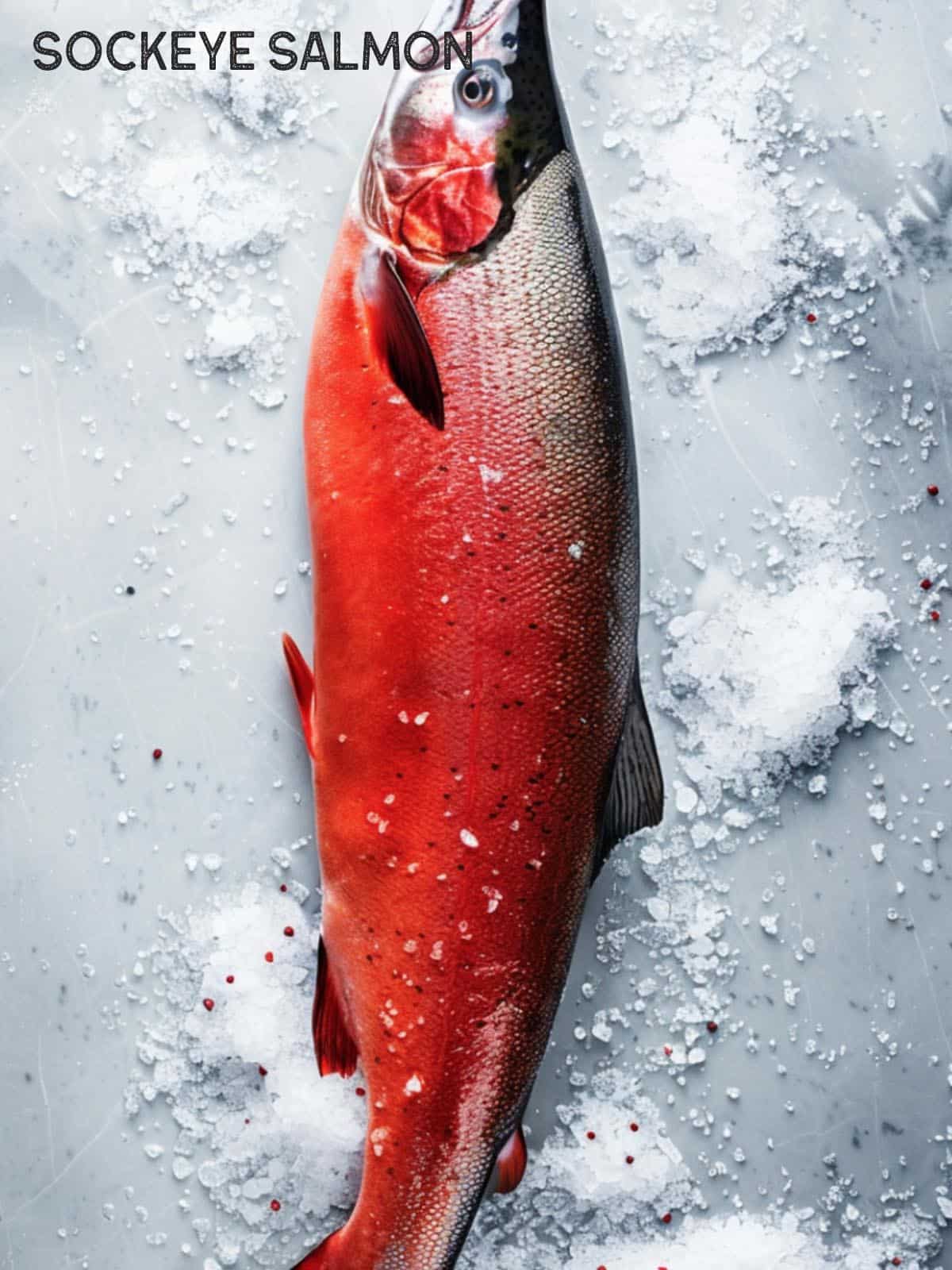
Coho
- Flavor Profile: Milder than Chinook or Sockeye, with a subtly sweet undertone. Check more information about Coho Salmon here.
- Texture: Delicate and flaky, a great choice for those who find salmon flavors strong.
- Ideal Cooking Methods: Baking, pan-searing (develop a crispy skin!), poaching (ideal in gentle sauces like dill and lemon), and light grilling.
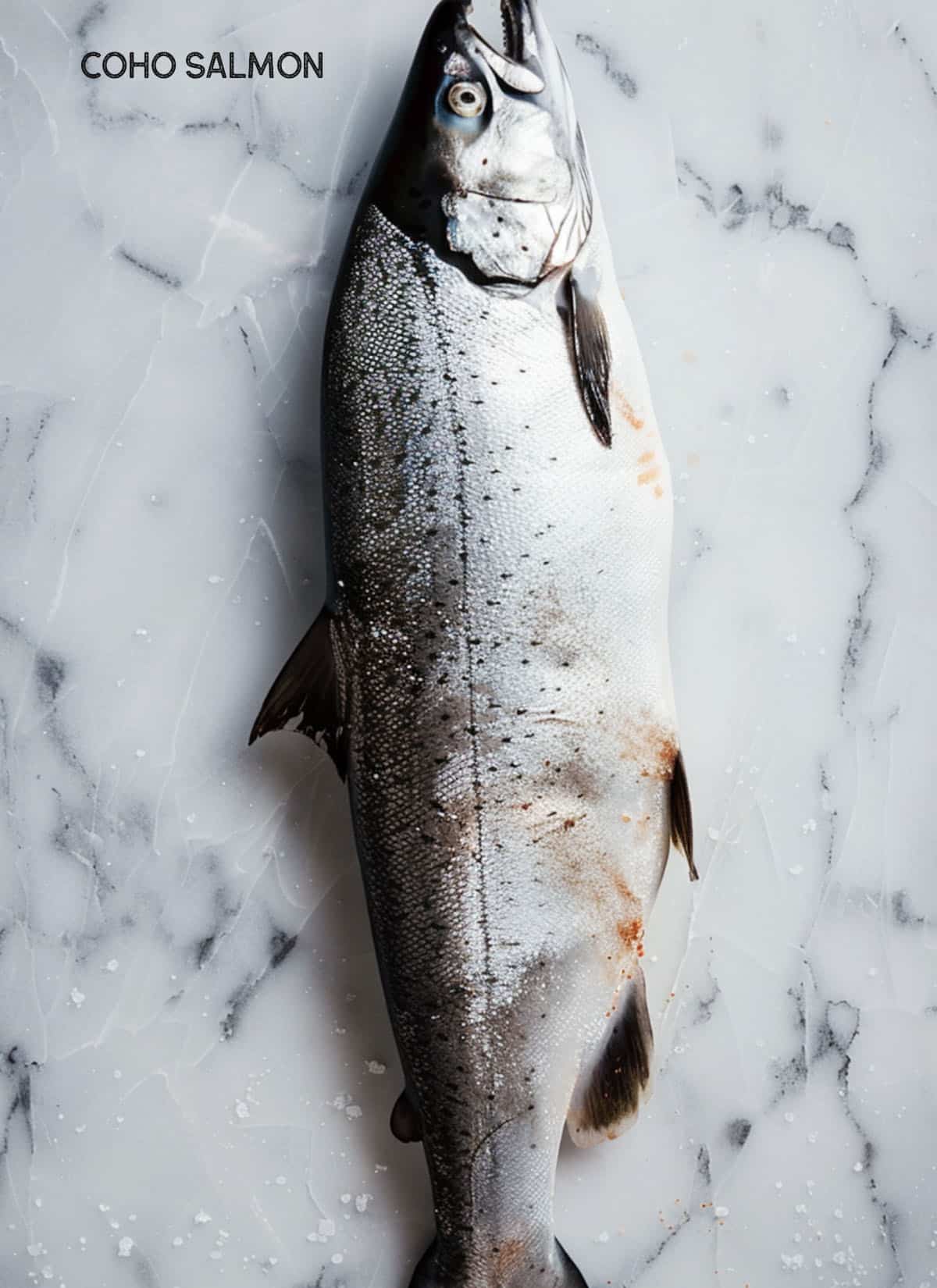
Atlantic
- Flavor Profile: The most common farmed variety, known for its mild flavor, medium fat content, and adaptability, takes well to a wide range of sauces and flavors. Read here to learn more.
- Texture: Medium-firm, versatile for different cooking applications.
- Ideal Cooking Methods: Works well with nearly every method – baking, grilling, pan-searing, poaching. Atlantic salmon's adaptability is a major strength.
Wild-Caught vs. Farmed
Wild-Caught
- Flavor: Often a more pronounced "salmon" flavor, influenced by their natural diet.
- Sustainability: Generally considered more eco-friendly, supports natural ecosystems.
- Considerations: It can be more expensive, with some seasonal availability restrictions.
Farmed
- Flavor: Milder flavor profile, more consistent throughout the year.
- Sustainability: Concerns about environmental impact, antibiotic use, and feed sources.
- Considerations: More widely available, often more affordable, labeling systems (ASC) help identify sustainable choices.
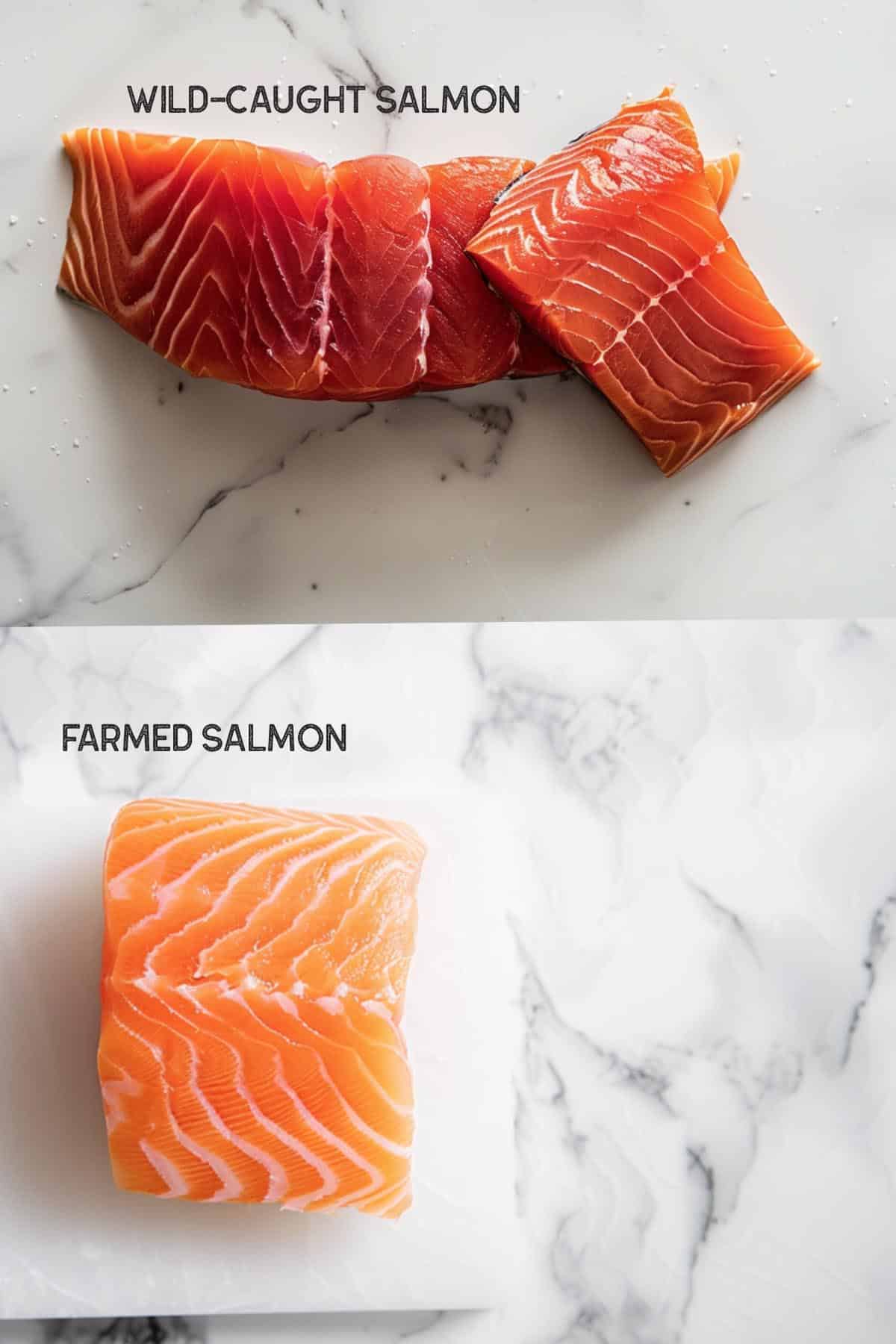
Sustainability:
- Wild-Caught: Supports natural fish populations and marine ecosystems—minimal direct environmental impact (but consider overfishing of certain wild species).
- Farmed: Can contribute to pollution, habitat alteration, and potential impact on wild fish populations through escapes and disease spread. Farmed fish depend on feed, which may put pressure on other fish stocks. However, farming practices are continually evolving to reduce environmental impact.
Nutritional Differences
- Omega-3s: Wild-caught Salmon generally has higher levels of omega-3 fatty acids due to its natural diet. However, some farmed salmon producers are adjusting feed to increase omega-3 content.
- Contaminants: Wild caught may have lower levels of some contaminants (like PCBs), but it depends on specific locations. Farmed Salmon may be exposed to antibiotics or pesticides used in their feed.
- Other Nutrients: Vitamin and mineral content can vary slightly between wild and farmed, but both are still excellent sources of healthy nutrients.
Navigating Labeling
Wild-Caught: Look for clear labeling stating "Wild" or "Wild-Caught." Be aware of misleading terms like "Ocean-Ranched."
Farmed: Labels often indicate the country of origin. Look for reputable certifications, such as ASC (Aquaculture Stewardship Council). This label indicates that farmed salmon was raised according to standards that minimize environmental impact.
MSC (Marine Stewardship Council): This certification signifies that a wild salmon fishery is responsibly managed and maintains healthy fish populations. Indicates sustainable wild fishing practices (not applicable to farmed).
Beyond Labels: Do your research! Investigate brands and sustainable fishing or farming practices and check independent resources for guidance.
Six Salmon Cooking Techniques
1 Baking Salmon
Why Baking? It's beginner-friendly, versatile, and delivers consistently delicious results. You can read my post on how to bake salmon for a more comprehensive guide. If you're looking for a flavorful twist, try my Baked Furikake Salmon recipe.
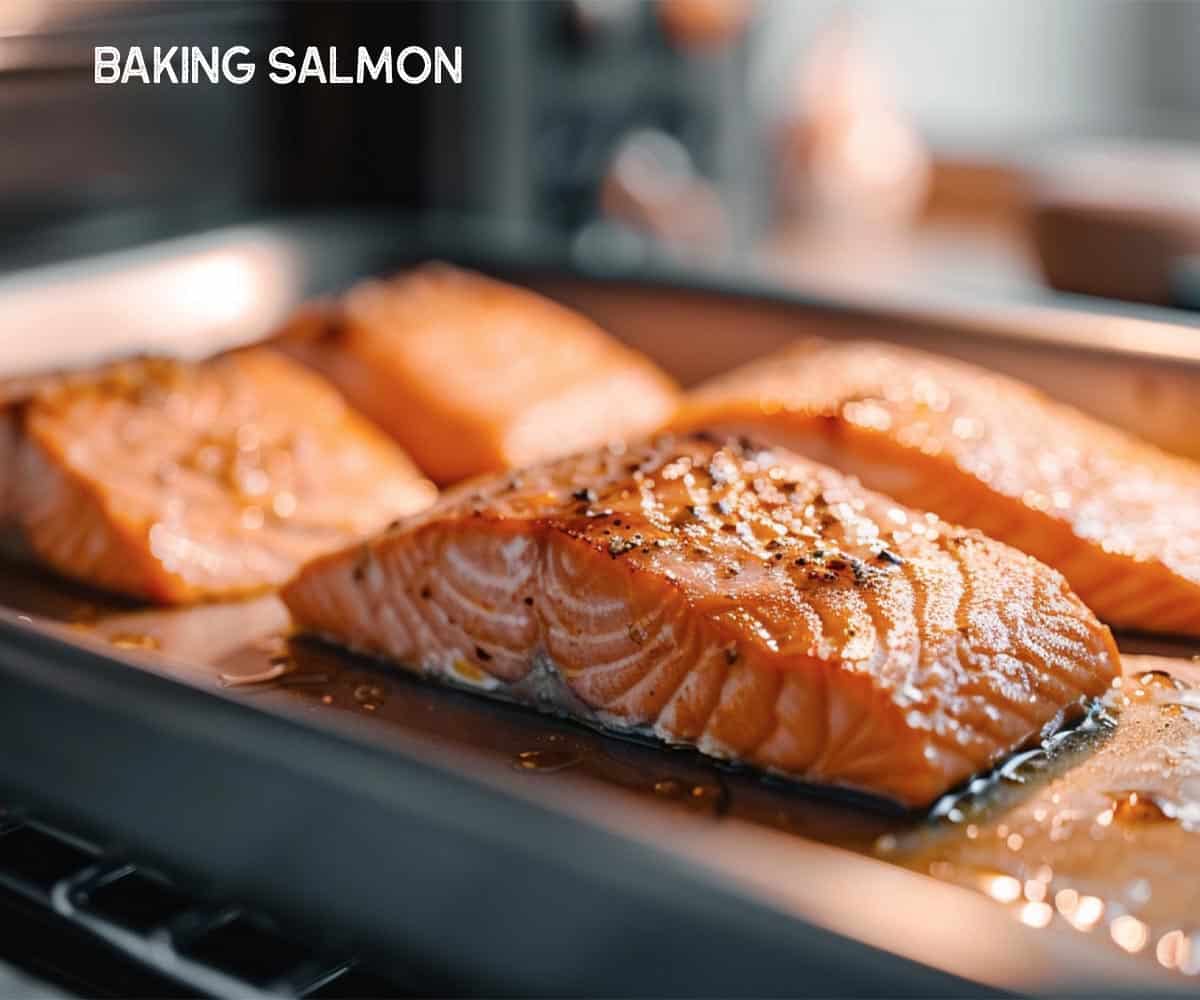
- Temperature and Timing: 400°F (200°C) is a reliable starting point. For a standard 6-ounce fillet, bake for 12-15 minutes or until the salmon flakes easily with a fork. Internal temperature should reach 145°F (63°C).
- Herbs and Spices: Keep it classic with lemon-herb (dill, parsley, thyme), garlic-butter, or try a Dijon-honey glaze. Get creative with spice blends as long as they complement the salmon flavor.
- Foil or Parchment: Parchment paper creates gentle steam, ideal for delicate types. Foil packets lock in moisture, which is good for bold marinades. Baking directly on a lined sheet pan works, too!
- Troubleshooting:
- Dryness: Avoid overcooking! Use a thermometer or gently press the top – it should yield slightly but bounce back.
- Albumin: The white substance that sometimes appears is harmless. Pat salmon dry before seasoning to minimize it.
- Suitable Salmon Types: Chinook, Sockeye, Coho, Atlantic – they all do beautifully in the oven!
2 Grilling Salmon
Why Grilling: It imparts a smoky flavor, is great for crispy skin, and is suitable for various salmon types. Find our delicious grilled salmon recipe here.
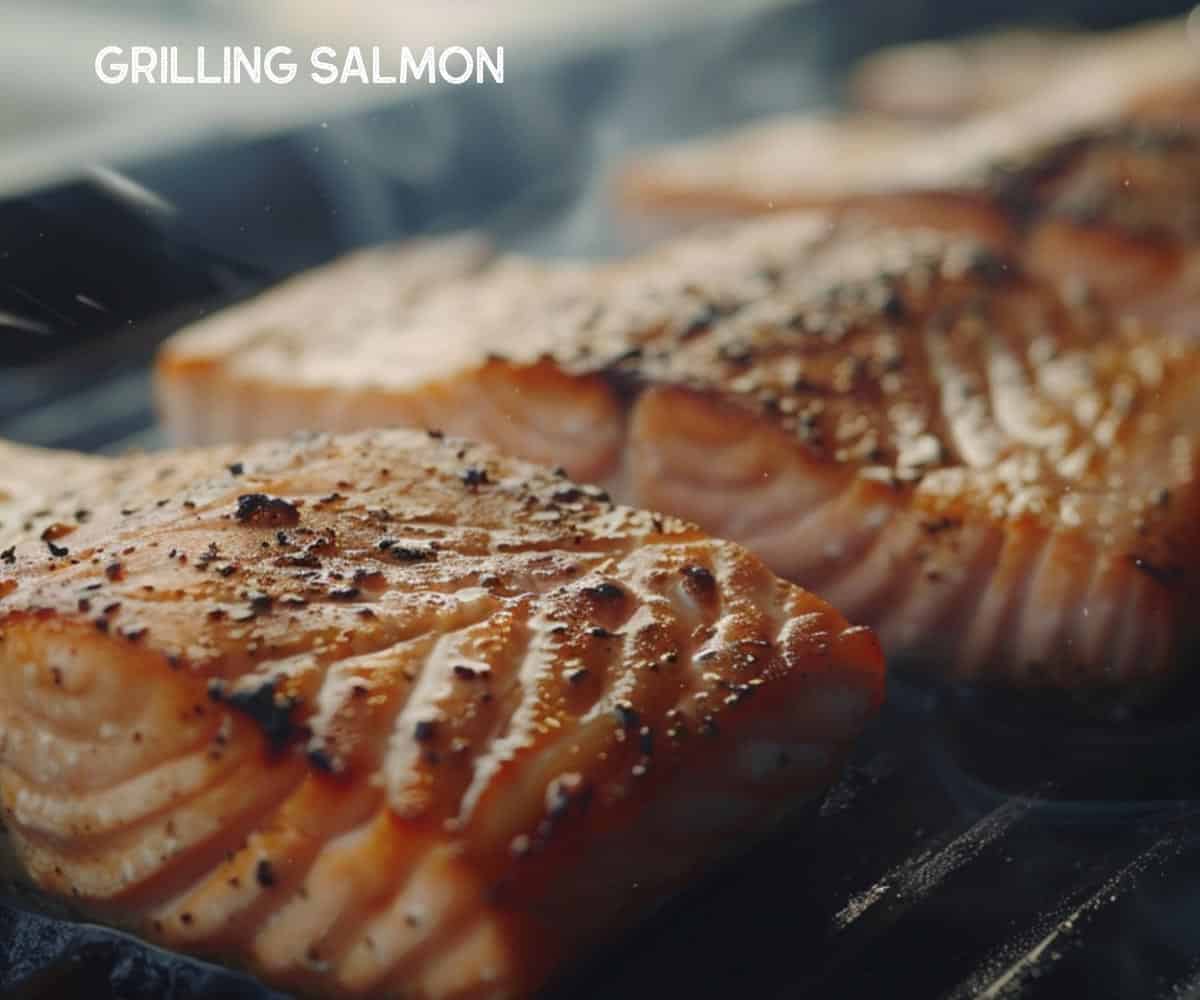
- Heat Control: Medium-high heat is ideal. You want a good sear without overcooking. Create a two-zone grill, if possible (hot and cooler sides) for control.
- Skin-On vs. Skin-Off: Skin-on is best on the grill – it prevents sticking and adds flavor. Score the skin lightly to help it cook evenly. Skin-off is possible, but use a well-oiled grill or a grilling basket.
- Marinades and Dry Rubs: Teriyaki, sweet & smoky BBQ rubs, lemon-pepper – get creative! Marinate for at least 30 minutes if time allows.
- Plank Grilling: Cedar planks are classic. Pre-soak planks and the gentle steaming add incredible flavor (especially good with rich salmon).
- Timing: Grill skin-side down for most of the cooking, then a brief flip to finish. Timing depends on thickness, but 4-6 minutes per side is a guideline.
- Troubleshooting:
- Sticking: Ensure the grill is clean and hot, oil the fish if skinless, and be patient before flipping.
- Overcooking: Use a thermometer or look for firm flesh that flakes easily with a fork.
- Suitable Salmon Types: Chinook, Sockeye, and Coho excel on the grill. Atlantic works, too, but monitor closely for overcooking.
3 Air-Frying Salmon
Why Air Fry: Air-frying offers so many benefits, it's fast cooking, crispy skin (if desired), minimal oil needed, making it a healthy option. Want a delicious example? Check out our Furikake Salmon Air Fryer recipe.
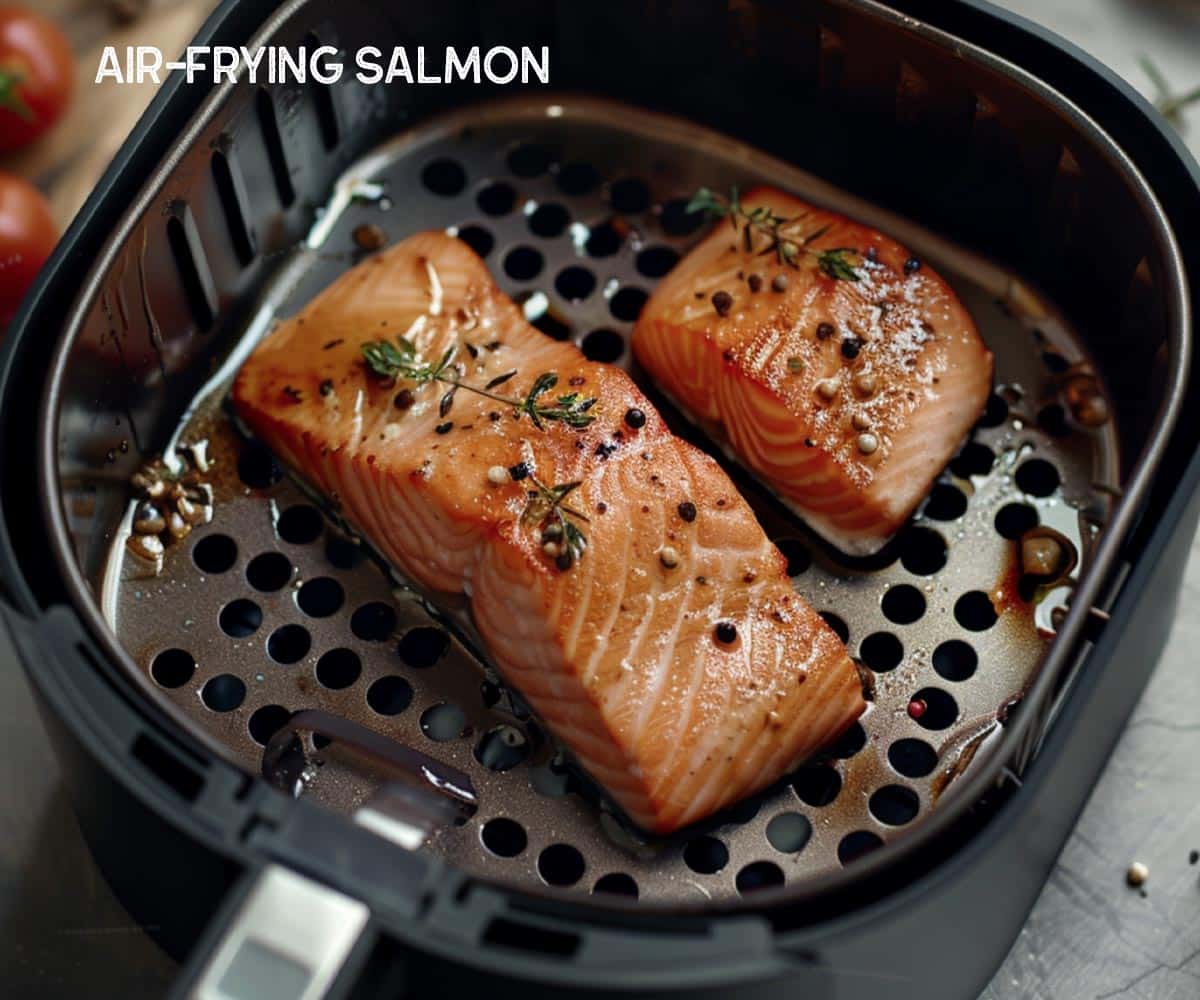
- Temperature and Timing: Preheat the air-fryer to 400°F (200°C). Cook time varies, but a starting point is 8-10 minutes for a standard fillet. Adjust based on your air fryer model and the thickness of the fish.
- Skin-On or Off: Both work well! Skin-on will become crispy, while skinless offers a lighter option—season well for both varieties.
- Minimal Oil: A light spritz helps crispiness but isn't strictly necessary. Use a high-heat oil if desired.
- Doneness: Like other methods – look for flaky flesh and an internal temp of 145°F (63°C). Overcooked salmon becomes dry, so keep an eye on it.
- Marinades vs. Dry Rubs: Both work! Dry rubs are excellent for achieving a crispy finish. For marinated fish, pat dry before air-frying to enhance browning.
- Suitable Salmon Types: All salmon types can be air-fried; thicker cuts are particularly convenient.
4 Pan-Searing Salmon
Why Pan-Searing: Ideal for developing a crispy, flavorful crust. It offers good control and is great for smaller portions.
Pan-searing is a great way to achieve a crispy crust on your salmon, and I cover the technique in more detail in another post [Pan Seared Salmon].
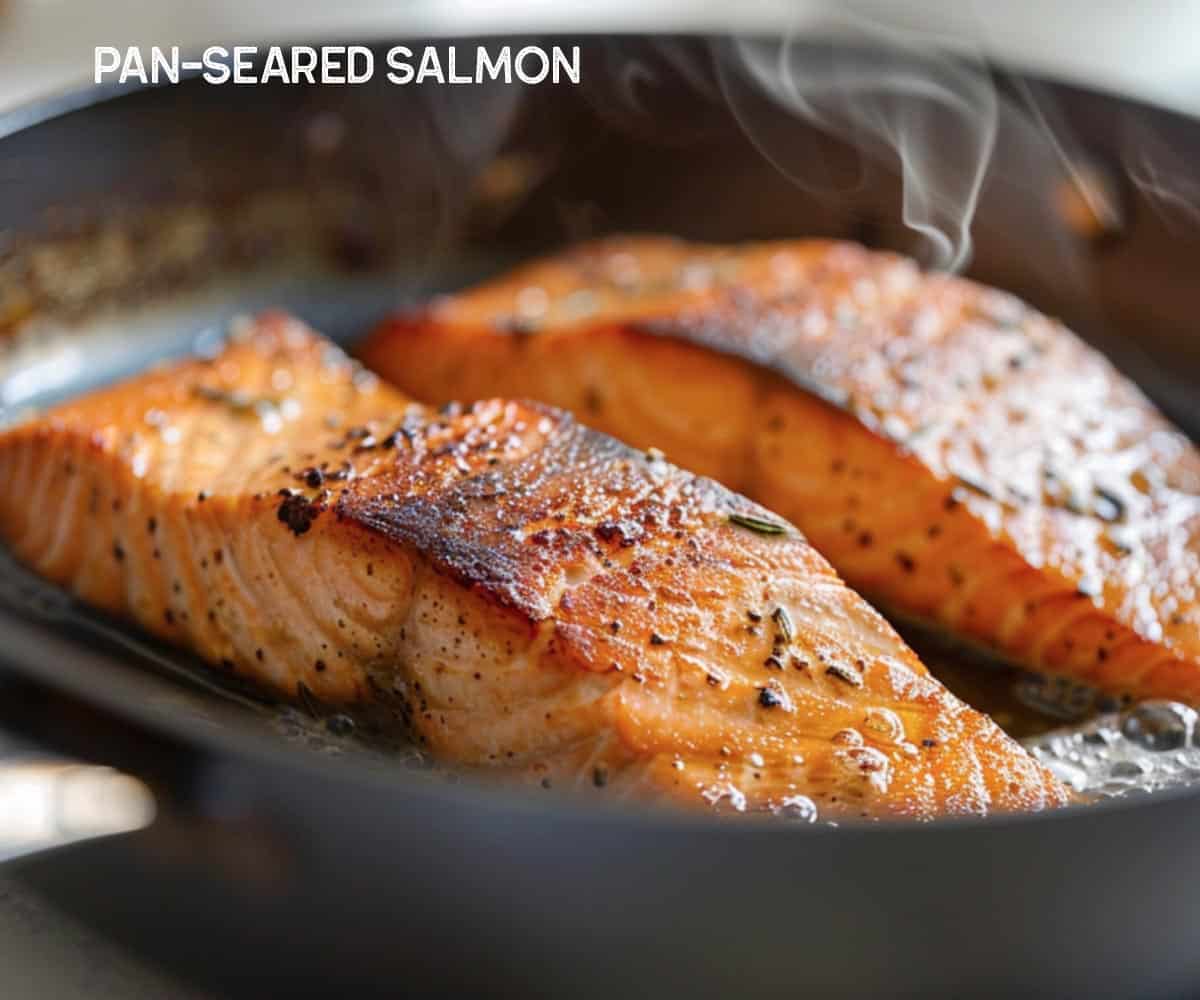
- Pan Choice: Cast iron is ideal for heat retention. Nonstick works well, too, ensuring it's well-seasoned.
- High-Heat Oil: Use oils with a high smoke point, like avocado, canola, or grapeseed. Avoid olive oil, as it may smoke too much.
- The Sizzle Test: Heat pan over medium-high. A drop of water should sizzle and evaporate immediately; that's when you add your oil.
- Seasoning and Skin: Pat salmon dry. Season right before cooking. Score the skin lightly if it's skin-on to help it stay flat.
- Placement and Timing: Gently lay salmon away from you (prevents oil splatter). Avoid overcrowding the pan. Cook skin-side down for most of the cooking, only flipping the last 1-2 minutes.
- Doneness: Gently press the thickest part - it should feel firm but with a slight give. Flaking with a fork is another indicator—an internal temperature of 145°F (63°C) for ideal results.
- Pan Sauces: The key to pan-searing! A splash of milk, wine, lemon juice, broth, a pat of butter – build flavor right in the pan.
- Suitable Salmon Types: All salmon types fare well, but skin-on is preferable for pan-searing.
5 Poaching Salmon
Why Poaching: It's a gentle method, ideal for delicate salmon types. It infuses flavor from the poaching liquid and keeps fish incredibly moist – learn more about the technique in my poached salmon post.
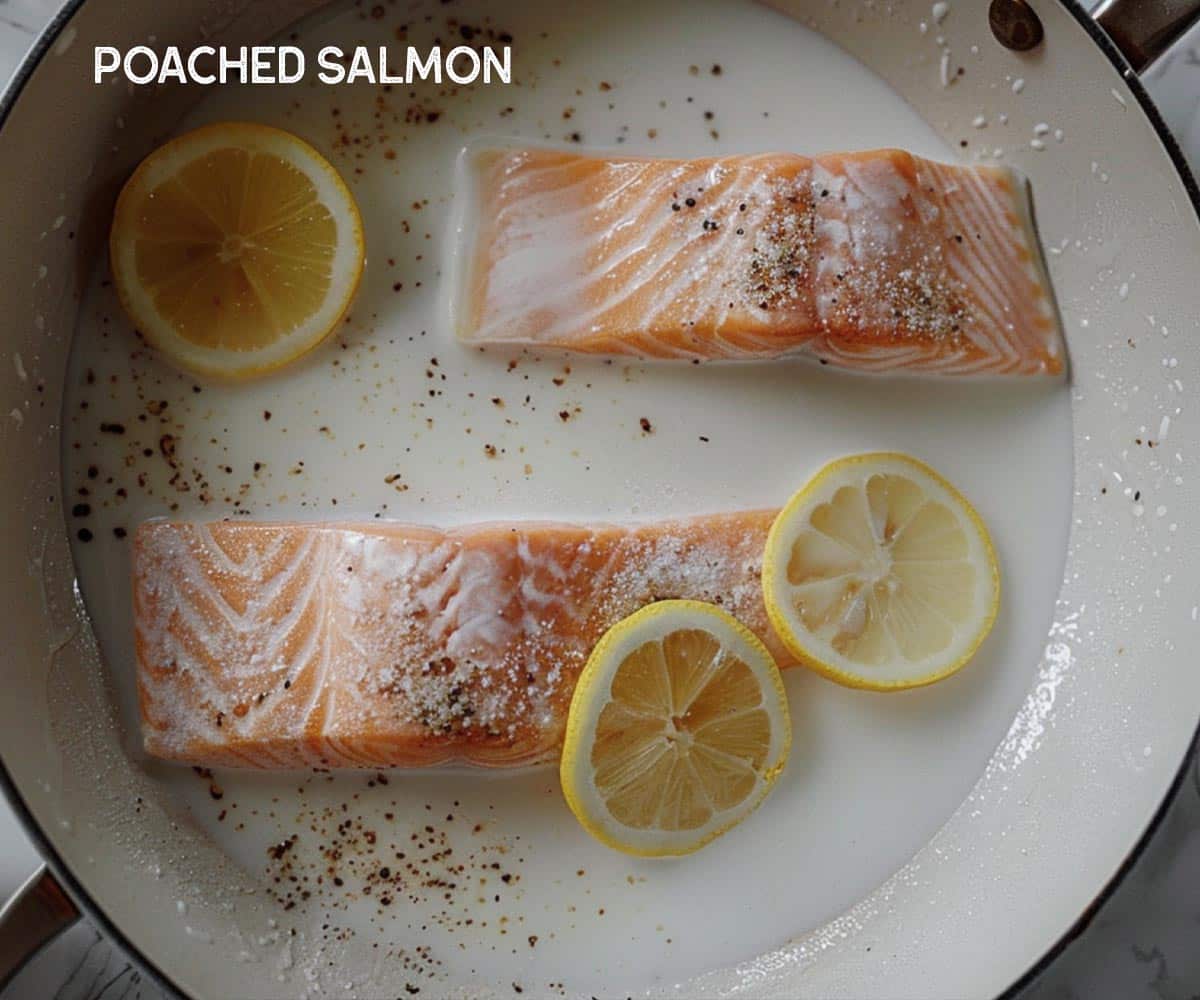
- Poaching Liquid: Go beyond water! Flavorful options include:
- Court bouillon (white wine, aromatics, herbs)
- Vegetable or chicken broth
- Coconut milk (for Asian-inspired flavors)
- Citrus and herb combinations
- Temperature: A gentle simmer is key (around 160°F -180°F). Avoid a rolling boil to prevent overcooking the salmon.
- Aromatics: Enhance your liquid with sliced onions, garlic, fresh herbs, and even a splash of wine for extra flavor.
- Timing: Poaching is relatively quick. Plan on 5-10 minutes, depending on the thickness of the salmon, and adjust based on your poaching liquid.
- Doneness: Flakiness is still a good indicator, but also look for a change in color from translucent to opaque. A thermometer inserted should read 125°F-130°F (52°C - 54°C) for a tender, slightly rare interior.
- Serving Options: Poached salmon is wonderful flaked over salads, in creamy pasta sauces, or served with a flavorful sauce on the side.
- Suitable Salmon Types: Delicate types like Coho truly shine with poaching. Chinook and Sockeye work too, just keep an eye on timing.
6 Smoking Salmon
Why Smoking: It imparts rich smoky flavor, transforms the texture, and is suitable for long-term preservation. You can check the Hot Smoked Salmon recipe here.
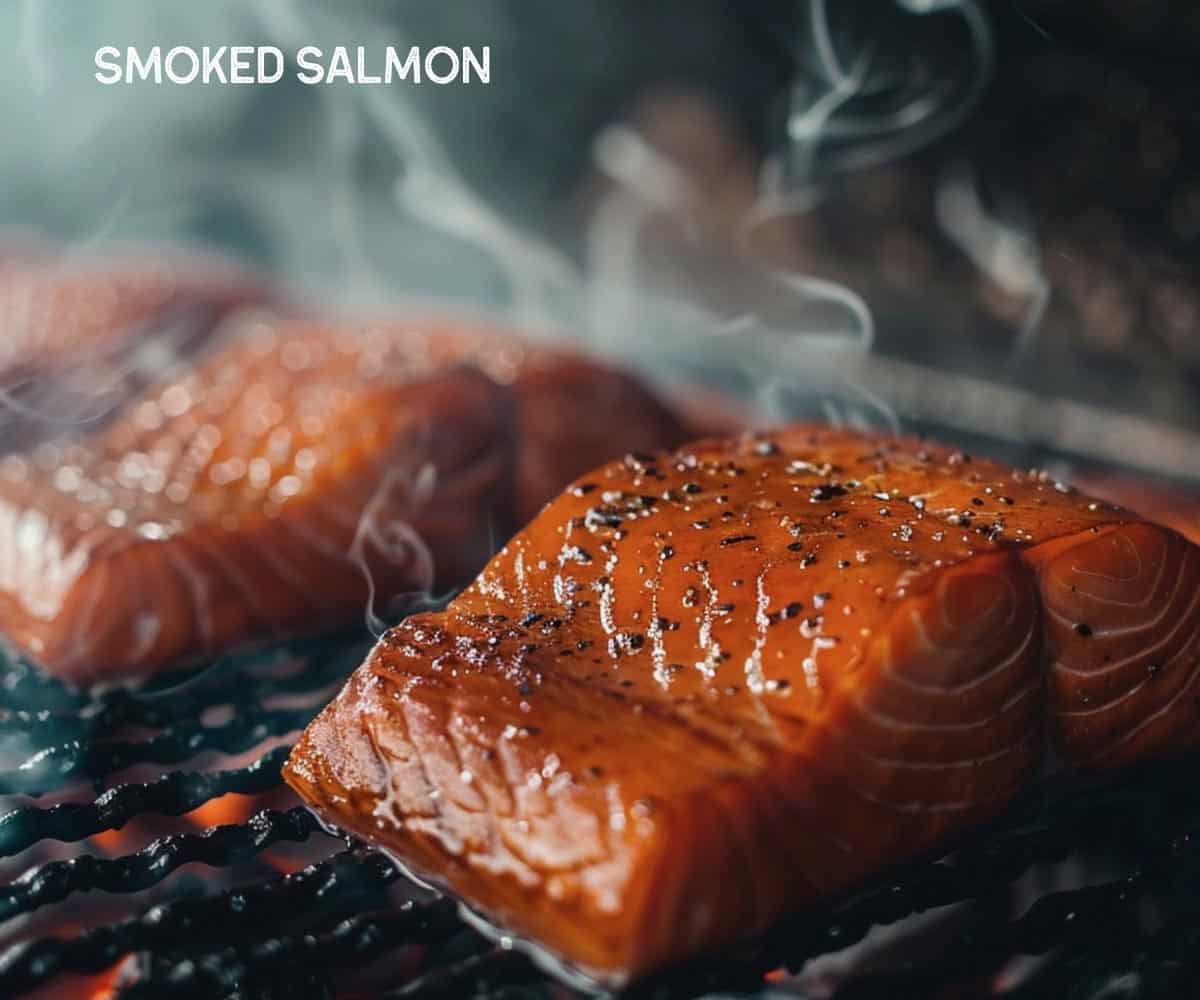
- Types of Smoking: Hot smoking fully cooks the fish, while cold smoking preserves it over time. For this guide, let's focus on hot smoking as it's more accessible to home cooks.
- Equipment: Smoker setups range from dedicated smokers to stovetop options or modified grills. A basic overview and resource links would be helpful here.
- Wood Chip Selection:
- Fruitwoods (apple, cherry) offer mild, sweet smoke (excellent for salmon).
- Hickory and mesquite deliver a bolder flavor.
- Oak is a good middle ground.
- Brining (Optional): A simple saltwater brine before smoking helps retain moisture and seasons the salmon.
- Temperature and Timing: Aim for a low smoker temp (225°F-250ºF). Smoking is slower than other methods – plan on several hours depending on salmon thickness. Doneness is best judged by temperature (145°F/63°C), but it shouldn't flake like other cooked salmon.
- Suitable Salmon Types: Chinook, Sockeye, and Coho take well to smoking due to their higher fat content.
Global Flavors for Salmon
Why Flavor Profiles: Salmon's adaptability makes it a culinary canvas. Exploring different flavor profiles highlights diversity and encourages experimentation.
- Asian-Inspired:
- Classics: Teriyaki sauce, soy-ginger, miso marinades/glazes.
- Beyond Basics: Sweet chili sauce, Thai-inspired coconut curry, sriracha-lime.
- Mediterranean:
- Essentials: Lemon, olive oil, garlic, herbs (oregano, thyme, dill), olives, capers.
- Variations: Yogurt-based sauces, tomato, and feta, roasted vegetables.
- Latin American:
- Spice It Up: Chili-lime marinades, chipotle rubs.
- Freshness: Mango salsa, pineapple salsa, avocado crema.
- Classic and Versatile:
- Reliable Go-Tos: Lemon-herb, garlic-butter, Dijon-honey.
Example Recipes:
- Miso-Glazed Salmon with Sesame Broccoli
- Baked Teriyaki Salmon
- Honey Glazed Salmon
- Mediterranean Baked Salmon with Tomatoes, Olives, and Feta
- Spicy Chipotle Salmon with Mango Salsa
Sauces and Marinades for Salmon
Why this Matters: Showcases salmon's versatility and how to tailor flavors to cooking methods.
Categories:
- Classic and Versatile:
- Lemon-Herb: Variations, how to use different cooking techniques.
- Garlic-Butter: Pan sauces built from this base.
- Dijon-Honey: Glazes, how sweetness balances flavors.
- Global Influences:
- Teriyaki: Homemade versions vs. store-bought.
- Miso: Types of miso (white, red), pairing with other ingredients.
- Yogurt-Based: Mediterranean, Indian-inspired variations.
- Bright and Fresh:
- Salsas: Mango, pineapple, tomato-based, etc.
- Herb-Based: Chimichurri, pesto (beyond basil).
- Spicy and Bold:
- Chili-Lime: Marinades and finishing sauces.
- Sriracha: Glazes, pairings with cooling elements.
Marinades vs. Sauces: Understanding the Differences
- Marinades
- Purpose: Infuse flavor into the raw salmon and tenderize the flesh.
- Components: Typically include an acid (lemon juice, vinegar), oil, and seasonings.
- Marinating Times: 30 minutes to several hours, but too long can make fish mushy. It is ideal for thinner cuts or quick cooking methods.
- During Cooking: Most of the marinade is discarded for safety, and flavor is primarily absorbed into the surface of the salmon.
- Sauces
- Purpose: Primarily add flavor and moisture after or during the cooking process.
- Components: Diverse! From simple pan sauces to herb-based, creamy, or fruit salsas.
- During Cooking: Can be used to baste (glazes), simmered to reduce, and intensify flavor, or served on the side for dipping.
- After Cooking: Ideal for finishing a dish with a burst of fresh flavor or keeping cooked salmon moist.
When to Choose Marinades:
- Quick Cooking: Pan-searing, grilling thinner cuts.
- Infusing Flavor: When you want the flavors to penetrate throughout.
- Tenderizing (slightly): The acid in marinades can slightly break down the fish's protein.
When to Choose Sauces:
- Delicate Fish: Sauces are gentle and good for poaching or when you don't want to overpower the salmon.
- Building Flavor as You Cook: Pan sauces, reductions, glazing during grilling.
- Versatility: Serve on the side, offering dipping options and flavor adjustments at the table.
Combining Both!
- A short marinade for base flavor, then finish with a complementary sauce.
- Glaze towards the end of grilling or baking with a flavorful sauce.
Here are a few examples of how to combine marinades and sauces for delicious salmon dishes –
1 Asian-Inspired Flavor Boost
- Marinade: A short (30 minutes) marinade with soy sauce, ginger, garlic, and a touch of honey. This gives the salmon a savory-sweet base flavor.
- Sauce: While the salmon grills or bakes, whisk together a sauce with some reserved marinade, rice vinegar, sriracha for heat, and a drizzle of sesame oil. Glaze the salmon in the last few minutes of cooking.
2 Mediterranean Delight
- Marinade: Lemon juice, olive oil, oregano, garlic, and a pinch of salt. Marinate up to 2 hours.
- Sauce: While the salmon bakes, create a simple yogurt sauce with Greek yogurt, chopped cucumber, dill, lemon juice, and a touch of garlic. Serve alongside the cooked salmon.
3 Citrus and Herb Burst
- Marinade: A vibrant blend of lemon zest, orange zest, fresh rosemary, olive oil, and salt. Marinate salmon for 30 minutes to an hour.
- Sauce: As the salmon pan-sears, deglaze the pan with white wine, and a squeeze of lemon, then whisk in butter and chopped chives for a bright, rich sauce to spoon over the finished fish.
Tips for Success:
- Complementary Flavors: Ensure your marinade and sauce work together, not against each other.
- Cooking Method Matters: Glazes work well in the final stages of grilling or baking. Pan sauces develop during cooking.
- Taste as You Go: Adjust your sauce for sweetness, acidity, or spice for the perfect balance.
Seasonal Pairings for Salmon
Why Seasonal Pairings Matter: Emphasizes freshness, complements the natural flavors of both salmon and in-season produce, and inspires creativity.
Here's a breakdown by season:
Spring
- Produce: Asparagus, fresh herbs (dill, parsley, mint), peas, young spinach, lemons.
- Flavors: Light, bright, herbaceous
- Recipes:
- Lemon-Herb Salmon with Roasted Asparagus
- Salmon with Spring Pea and Mint Pesto
Summer
- Produce: Berries, zucchini, tomatoes, bell peppers, corn, stone fruits (peaches, nectarines).
- Flavors: Sweet & savory combos, vibrant, grilling-friendly
- Recipes:
- Grilled Salmon with Blueberry Salsa
- Mediterranean Salmon with Zucchini and Tomato Salad
Autumn
- Produce: Root vegetables (potatoes, carrots, parsnips), Brussels sprouts, squash, apples.
- Flavors: Warm spices, hearty, roasted
- Recipes:
- Maple-Glazed Salmon with Roasted Brussels Sprouts and Apples
- Sheet Pan Salmon with Roasted Root Vegetables
Winter
- Produce: Citrus fruits, kale, hearty greens, winter squash, pomegranate.
- Flavors: Cozy, citrusy, bold
- Recipes:
- Baked Salmon with Pomegranate Glaze and Roasted Kale
- Spiced Salmon with Butternut Squash
Health Considerations for Salmon
Omega-3 Fatty Acids:
Omega-3s in salmon are like superheroes for your heart, brain, and overall well-being. They help combat inflammation, support healthy blood pressure, and improve cognitive function.
Did you know the Omega-3 punch varies between salmon types? Fatty varieties like Chinook and Sockeye pack the most, but all types are beneficial sources.
Heart-Healthy Choice:
Salmon wins out over many red meats in terms of heart health, thanks to its Omega-3s and lower saturated fat content. It's a smart swap for your ticker!
Research suggests including salmon in your diet may help lower cholesterol, improve blood pressure, and reduce the risk of heart disease.
Protein and Nutrients:
Salmon is more than just delicious; it's a nutritional powerhouse. A single serving provides a significant boost of protein, essential vitamins like Vitamin D and B12, and important minerals like potassium and selenium.
Potential Contaminants:
It's important to be aware that salmon, like many fish, can contain traces of mercury and other contaminants. Thankfully, the benefits of salmon far outweigh the risks for most people.
Stick to recommended serving amounts (check the FDA website) and prioritize safer varieties like wild-caught Alaskan salmon. Diversifying your seafood choices is also a smart move.
Dietary Restrictions
Salmon itself is naturally gluten-free, low-carb, and dairy-free. Pair it with the right sides and sauces; it becomes a star for numerous dietary plans.
Examples:
- Low-Carb/Keto: Enjoy salmon with roasted vegetables, cauliflower rice, or a vibrant salad for a satisfying meal.
- Paleo: Stick to marinades and sauces made with whole-food ingredients. Pair with roasted root vegetables or a colorful stir-fry.
- Dairy-Free: Opt for oil-based marinades, citrus, and herb sauces, or fresh and flavorful salsa.
Specific Restrictions
- Low-Carb/Keto: Pair salmon with roasted vegetables, cauliflower rice, or a fresh salad.
- Paleo: Focus on whole-food marinades and spice rubs. Enjoy with roasted sweet potatoes or a colorful veggie stir-fry.
- Dairy-Free: Opt for flavorful marinades and herb-based sauces.
Pregnancy & Young Children:
Omega-3s in salmon are essential for healthy pregnancy and a child's brain development. Just watch portion sizes and choose low-mercury varieties.
The FDA has specific guidelines for salmon consumption during pregnancy and young children. They recommend opting for varieties like wild-caught Alaskan or farmed Atlantic salmon.
Cooking Methods and Nutrient Retention
All cooking methods can cause some nutrient loss, but the goal is to choose methods that minimize it.
- Gentle Methods: Poaching, steaming, and baking preserve nutrients better, particularly water-soluble vitamins (some B Vitamins, Vitamin C).
- High-Heat Methods: Grilling, pan-searing, and even roasting can lead to more nutrient loss but still provide health benefits. Tips to minimize:
- Shorter cooking times
- Avoid overcooking or charring.
- Utilize any leftover juices (pan sauces)
- Omega-3s: Relatively stable during cooking, but extreme, prolonged heat can degrade them.
- Fat-Soluble Vitamins: Vitamins like A, D, and E (present in salmon) are less affected by cooking methods.
Why No Single Method is "Bad"
- Health Benefits Remain: While cooking causes some nutrient loss, salmon is still a powerhouse of nutrition compared to many other foods. Emphasize it's a valuable part of a healthy diet regardless of how it is prepared.
- Tradeoffs: Each cooking method offers benefits. Grilling imparts flavor many loves, even if it might sacrifice a small percentage of nutrients compared to steaming.
- Accessibility Matters: If someone hates poached salmon, forcing themselves to eat it that way isn't sustainable. Enjoying how your salmon is prepared is crucial.
Choice Based on Diet and Preference
- Diverse Dietary Needs: A person focusing on maximizing Vitamin C might lean toward gentler cooking methods, while someone on a low-fat diet might favor poaching or grilling.
- Flavor is King: The best salmon recipe is the one you'll actually eat! Encouraging experimentation keeps things enjoyable.
- Balance Over Time: Rather than obsessing over one meal, promote the idea of incorporating salmon cooked in different ways throughout the week or month for a well-rounded approach.
Side Dishes for Salmon
The Power of Sides: Side dishes complete your salmon experience! They add bursts of flavor, contrasting textures, and help create satisfying, balanced meals.
Categories to Explore
- Roasted Vegetables: The ultimate in versatility. Choose seasonal favorites and experiment with different seasonings - balsamic, honey-mustard, herbs, or a simple drizzle of olive oil and salt.
- Salads: From light arugula with lemon vinaigrette to hearty quinoa salads with roasted vegetables and a tangy dressing. Salads add freshness and a satisfying crunch.
- Rice & Grains: Think beyond plain rice! Try wild rice pilafs and flavorful lemon-herb rice, or try couscous or quinoa for delightful new textures.
- Potatoes: Whether creamy mashed, simply roasted with herbs, or transformed into a cheesy potato bake, potatoes are a classic salmon companion.
Tips for Perfect Pairings
- Flavor Match: Does your salmon have Mediterranean flavors? Pair it with roasted tomatoes, olives, and feta. Asian-inspired salmon loves a ginger-sesame slaw.
- Cooking Methods Matter: Rich, baked salmon calls for lighter sides, while grilled salmon can handle bolder accompaniments.
- Embrace the Seasons: Summery grilled salmon with corn on the cob is perfection, while autumn calls for a warm roasted root vegetable medley.
Recipe Suggestions
- Roasted Asparagus with Lemon and Parmesan: A timeless, easy favorite.
- Mediterranean Quinoa Salad: Vibrant vegetables, olives, and a zesty dressing.
- Garlic and Herb Roasted Potatoes: Crispy on the outside, fluffy within.
Classic and Simple
- Lemony Green Beans: Blanched or sautéed, tossed with lemon juice, butter, and toasted slivered almonds.
- Simple Roasted Broccoli or Broccolini: Tossed with olive oil, salt, pepper, and a touch of garlic powder. Roast until tender-crisp with browned edges.
- Herb-Roasted Carrots and Parsnips: A touch of maple syrup or honey adds a subtle sweetness.
Flavorful Twists
- Honey-Glazed Brussels Sprouts with Balsamic: Crispy roasted sprouts drizzled with honey and balsamic for a sweet-tangy combo.
- Garlic Parmesan Cauliflower Rice: A low-carb option full of flavor. Sautéed with garlic and finished with parmesan cheese.
- Creamy Polenta with Mushroom Ragout: Comforting and savory, polenta is a delightful base for a flavorful mushroom mixture.
Seasonal Flair
- Summer: Grilled Corn on the Cob with flavored butters (Chili-Lime, Herb-Garlic)
- Fall: Butternut Squash and Kale Salad with Maple Vinaigrette: Toasted nuts and dried cranberries add texture and sweetness.
- Winter: Roasted Sweet Potatoes with Pomegranate Seeds: Festive colors and a mix of sweet and tangy.
Serving Suggestions:
Quick and Easy:
- Sheet Pan Meals: Salmon with roasted vegetables, all cooked together for minimal cleanup.
- Salmon Bowls: Build your own with a base of rice/grains, roasted vegetables, salmon, and a drizzle of sauce.
- Simple Salads: Top a bed of greens with your cooked salmon for a light, healthy meal.
Dinner Party Worthy:
- Herb-Crusted Salmon: A show-stopping centerpiece served with an elegant side dish like Furikake Salmon.
- Salmon Wellington: Wrapped in puff pastry, impressive but surprisingly easy with the right recipe.
- Cedar Plank Salmon: It imparts a lovely smoky flavor and a sense of occasion.
Plating Tips:
A pop of color: Garnish with lemon wedges, fresh herbs, or edible flowers.
Contrasting Textures: Creamy risotto with crispy-skinned salmon.
"Build Your Plate" Option: Arrange salmon and sides separately for individual customization.
Meal Prepping with Salmon
Why Meal Prep? Saves time, reduces food waste, promotes healthy eating, and makes salmon accessible even on busy days.
- Cook Once, Eat Multiple Ways:
- Simple baked or grilled salmon is a versatile base for lunches and quick dinners.
- Transform leftovers: Salads, grain bowls, wraps, etc.
- Storage Tips:
- Proper cooked salmon storage (airtight container, fridge) for 3-4 days max.
- Reheating gently maintains the best texture.
- Prep-Ahead Sides: Suggest items that keep well:
- Roasted Vegetables (can be eaten cold or reheated)
- Grains like rice or quinoa
- Pre-washed lettuce and salad fixings
- Recipe Ideas:
- Salmon Salad with Lemon-Dill Dressing
- Mediterranean Salmon Grain Bowls
- Salmon Tacos with Mango Salsa (components prepped ahead)
Storing Leftover Salmon
Safe Storage:
Refrigeration is Key: Prevent spoilage and foodborne illness. Store cooked salmon in the coldest part of the refrigerator (usually the back or lower shelves) for optimal safety.
Airtight is Essential: Use glass containers with tight lids or reusable food-safe wraps like beeswax to prevent both odor absorption and drying out. Store container in the refrigerator, ideally consumed within 3-4 days.
Shallow is Better: Store salmon in shallow containers for faster cooling and more even reheating.
Signs of Spoilage:
Trust Your Senses: Go beyond just smell and texture. Does the salmon look discolored or have any mold growth? When in doubt, toss it out.
"Use By" Guideline: Even with proper storage, stick to the 3-4 day maximum for cooked salmon in the fridge for safety and best quality.
Creative Leftover ideas:
- Salmon Salad: Classic for sandwiches, wraps, or crackers.
- Salmon Cakes or Patties: Flavorful way to stretch leftovers.
- Salmon Fried Rice or Pasta: Toss cooked salmon into quick, tasty dishes.
- Soups and Chowders: A flavorful addition to creamy or broth-based soups.
Freezing
Quality vs. Convenience: Be clear that freezing is a safe option but impacts texture for the most enjoyable experience; cooked salmon is best fresh.
Ideal Uses: Frozen salmon is best used in dishes blended (salmon dip) or the texture is less noticeable, like casseroles and chowders.
Freezing Methods: Airtight packaging, label with date, and use within 2-3 months.
Storage Tips
- Cool Before Storing: Allow cooked salmon to come to room temperature before refrigerating. Hot food can raise the refrigerator's internal temperature.
- Portion Control: For meal prep, divide salmon into individual portions for easier reheating and to avoid unnecessarily warming up the entire batch.
- Label Clearly: Add a label to your storage container with the date the salmon was cooked for easy reference.
Reheating Tips
- Gentle is Best: Low, slow reheating methods help maintain the best texture. Avoid high heat or microwave on full power, which can make salmon dry.
- Stovetop: Reheat in a skillet with a touch of oil or butter over low-medium heat until just warmed through.
- Oven: Place salmon in a lightly greased baking dish, cover loosely with foil, and bake at a low temperature (around 275°F/135°C) until heated through.
- No Reheat Required: Leftover salmon is delicious cold! Perfect for salads, sandwiches, or as a protein-rich snack.
Extra Reheating Tips
1 Salmon Cakes/Patties: For optimal texture, gently reheat salmon cakes in a skillet with a little oil until crisp outside and heated through.
2 Frittatas/Omelets: Leftover salmon can be added directly to an omelet or frittata – no need to reheat separately since it will warm through during cooking.
3 Soups and Chowders: Add flaked cooked salmon near the end of the cooking process for soups and chowders until warmed through.
4 Salmon Salad: Best enjoyed chilled straight from the refrigerator. If making with warm cooked salmon, allow to cool fully before assembling.
5 Salmon Bowls: Reheat the base ingredients (grains, roasted vegetables) separately for optimal texture. Add cold, flaked salmon on top, or gently warm it through for just a minute or two.
6 Salmon Tacos/Wraps: Assemble components separately. Reheat the salmon gently (pan method is ideal, microwave cautiously on low power). Warm tortillas briefly, and provide crisp toppings (lettuce, slaw) to offset the softness of the reheated salmon.
7 Salmon Pasta with Cream Sauce: Prepare the sauce and noodles fresh. Gently warm the flaked salmon in a touch of the sauce, then toss everything together. This avoids overcooking the salmon.
8 Salmon and Potato Bake: Reheat in a low oven (around 300°F/150°C), covered, until fully heated through. A sprinkle of cheese or a drizzle of cream on top before reheating can add richness lost during storage.
Note: While proper storage helps preserve deliciousness, please note that leftover salmon's textures may differ slightly from freshly cooked. This is normal and doesn't affect safety!
Let's Customize It!
- My Favorite Reheating Method: I love pan-reheating! A touch of oil in a nonstick skillet over medium-low heat. Skin-side down first (if skin-on), then a gentle flip to warm the flesh. It adds a touch of crispness while maintaining the moist interior.
- Temperature Targets: For the ideal balance of safety and texture, aim to reheat leftover salmon to an internal temperature of 125-130°F/52-54°C.
Wine & Beverage Pairings for Salmon
Why Pairings Matter:
Complementary Flavors: The right beverage can highlight the natural flavors of the salmon or introduce contrasting elements for a balanced experience. For instance, a buttery Chardonnay mirrors the richness of King salmon, while a crisp Sauvignon Blanc cuts through the fattiness.
Texture Play: Beverages interact with the texture of the fish. Bubbly sparkling water offers a refreshing contrast to the richness of baked salmon, while a full-bodied red wine stands up to the heartiness of grilled salmon.
Flavor Profiles Are Key:
- Rich Salmon: (King/Chinook) pairs well with bolder whites (Chardonnay, Viognier) or lighter reds (Pinot Noir).
- Lean Salmon: (Sockeye, Coho) complements crisp whites (Sauvignon Blanc, Pinot Grigio) or delicate rosés.
- Flavored Salmon: Match the spice profile – Teriyaki calls for sweeter wines (Riesling), smoky grilled salmon pairs well with oaked Chardonnay.
Beyond Wine:
- Beer: Pilsners, pale ales, and wheat beers offer refreshing counterpoints to salmon.
- Non-Alcoholic: Sparkling water with citrus, herbal iced teas, and flavorful lemonades.
Recipe Suggestions
- Grilled Salmon with Herb Butter alongside a glass of Sauvignon Blanc.
- Teriyaki Salmon with a suggested Riesling pairing.
- Smoked Salmon on crackers with a sparkling water and lemon wedge.

